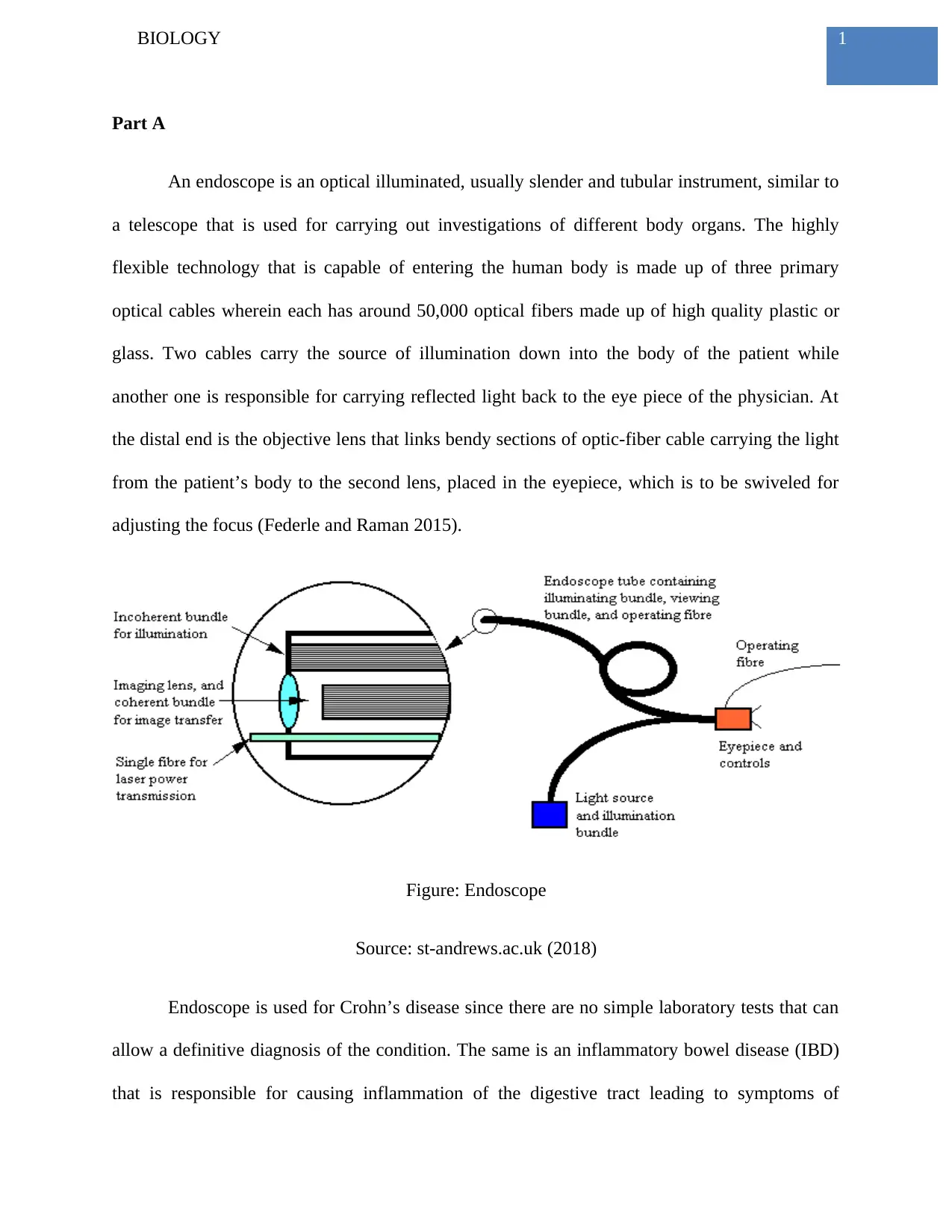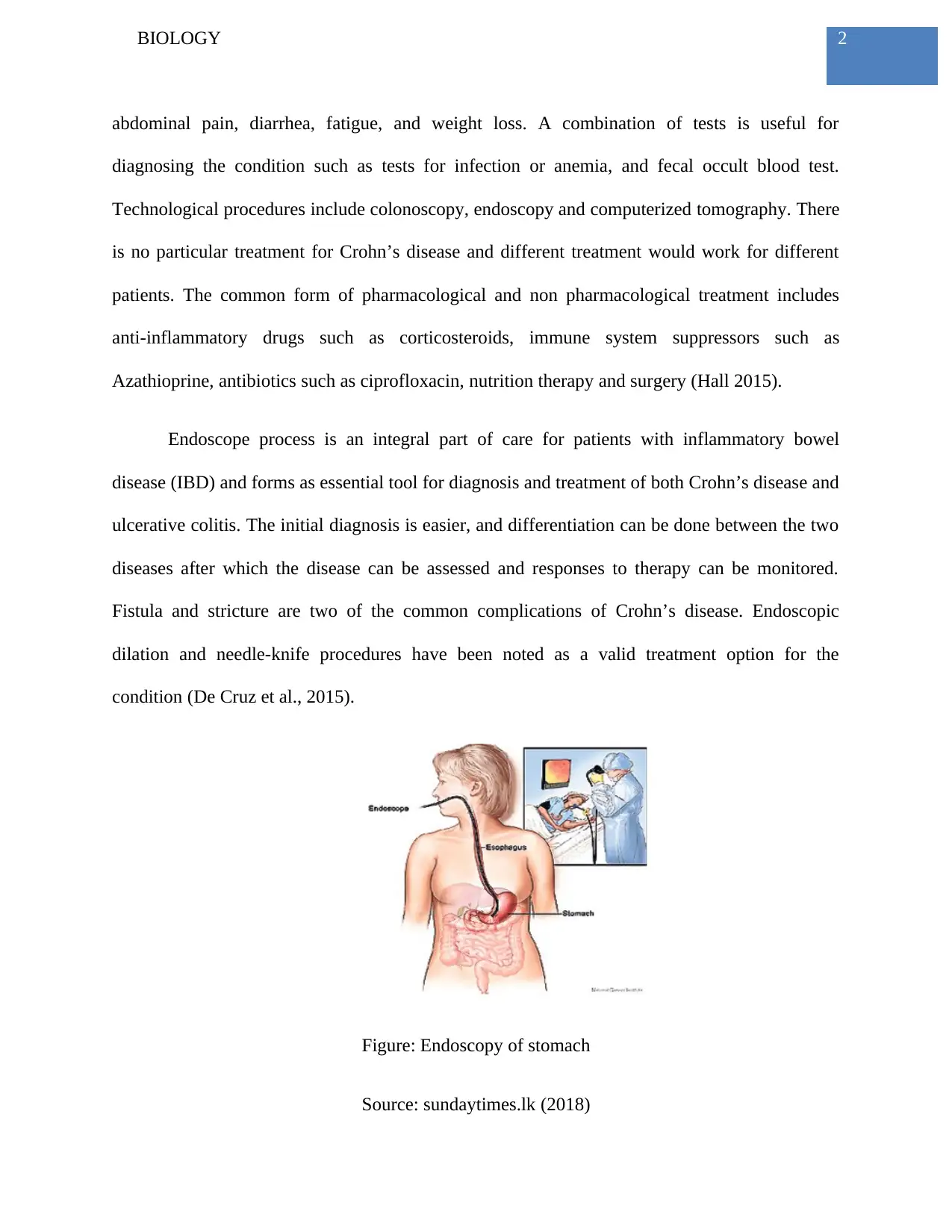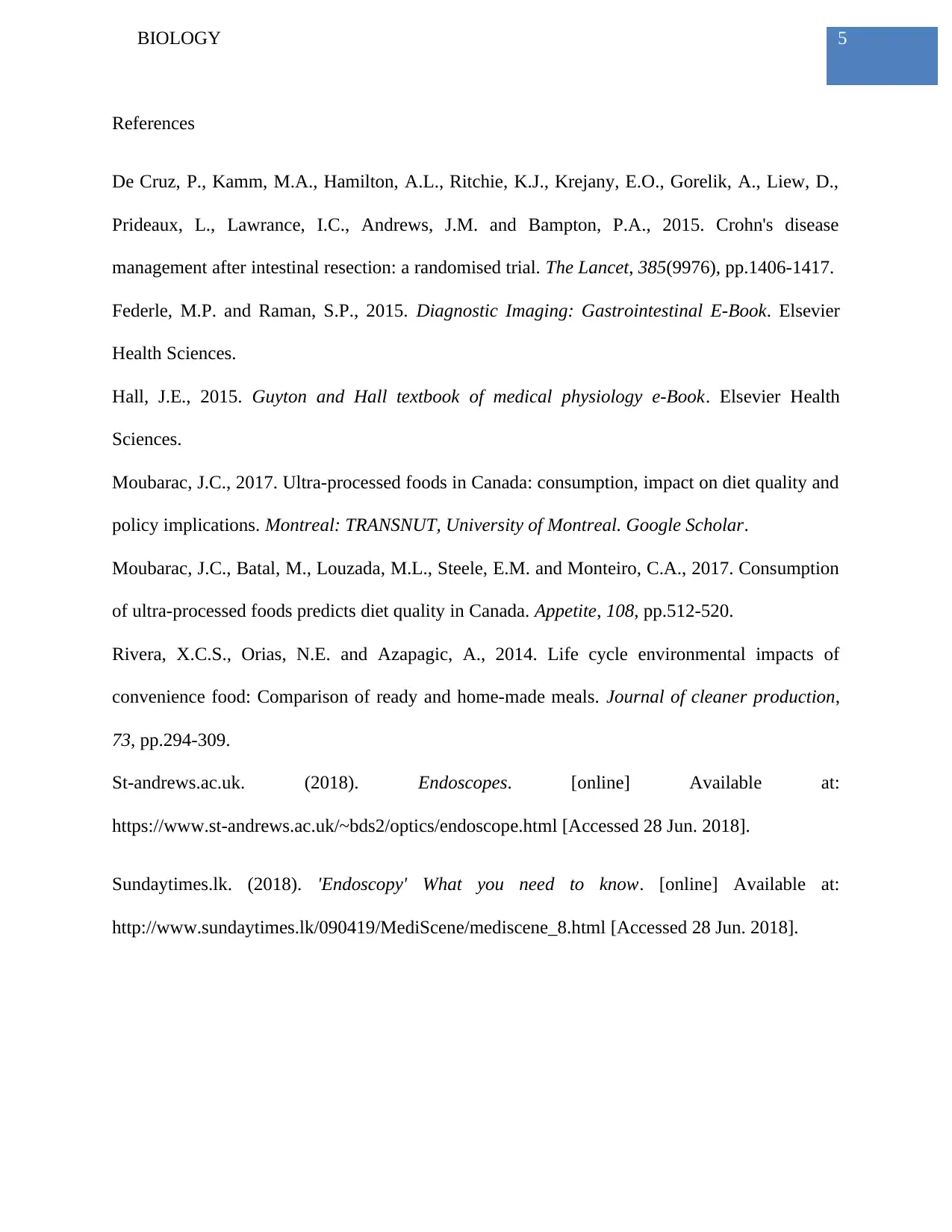Biology: Endoscopy for Crohn's Disease and Convenience Foods Impact
VerifiedAdded on 2023/06/10
|6
|1058
|469
Essay
AI Summary
This essay explores two distinct topics within biology. Part A discusses the use of endoscopy, a crucial diagnostic tool, in managing Crohn's disease, highlighting its role in diagnosis, treatment monitoring, and addressing complications like fistulas and strictures. It also touches upon the social acceptance and costs associated with endoscopic procedures. Part B shifts focus to the convenience food market in Canada, examining the influence of dietary trends and the lack of kitchen skills among younger generations. It emphasizes the detrimental health effects of these foods, including hypertension, diabetes, heart disease, and cancer, and discusses the Canadian healthcare system's efforts to address these issues through educational programs and potential tax adjustments.

Running head: BIOLOGY
Biology
Name of student:
Name of university:
Author note:
Biology
Name of student:
Name of university:
Author note:
Paraphrase This Document
Need a fresh take? Get an instant paraphrase of this document with our AI Paraphraser

1BIOLOGY
Part A
An endoscope is an optical illuminated, usually slender and tubular instrument, similar to
a telescope that is used for carrying out investigations of different body organs. The highly
flexible technology that is capable of entering the human body is made up of three primary
optical cables wherein each has around 50,000 optical fibers made up of high quality plastic or
glass. Two cables carry the source of illumination down into the body of the patient while
another one is responsible for carrying reflected light back to the eye piece of the physician. At
the distal end is the objective lens that links bendy sections of optic-fiber cable carrying the light
from the patient’s body to the second lens, placed in the eyepiece, which is to be swiveled for
adjusting the focus (Federle and Raman 2015).
Figure: Endoscope
Source: st-andrews.ac.uk (2018)
Endoscope is used for Crohn’s disease since there are no simple laboratory tests that can
allow a definitive diagnosis of the condition. The same is an inflammatory bowel disease (IBD)
that is responsible for causing inflammation of the digestive tract leading to symptoms of
Part A
An endoscope is an optical illuminated, usually slender and tubular instrument, similar to
a telescope that is used for carrying out investigations of different body organs. The highly
flexible technology that is capable of entering the human body is made up of three primary
optical cables wherein each has around 50,000 optical fibers made up of high quality plastic or
glass. Two cables carry the source of illumination down into the body of the patient while
another one is responsible for carrying reflected light back to the eye piece of the physician. At
the distal end is the objective lens that links bendy sections of optic-fiber cable carrying the light
from the patient’s body to the second lens, placed in the eyepiece, which is to be swiveled for
adjusting the focus (Federle and Raman 2015).
Figure: Endoscope
Source: st-andrews.ac.uk (2018)
Endoscope is used for Crohn’s disease since there are no simple laboratory tests that can
allow a definitive diagnosis of the condition. The same is an inflammatory bowel disease (IBD)
that is responsible for causing inflammation of the digestive tract leading to symptoms of

2BIOLOGY
abdominal pain, diarrhea, fatigue, and weight loss. A combination of tests is useful for
diagnosing the condition such as tests for infection or anemia, and fecal occult blood test.
Technological procedures include colonoscopy, endoscopy and computerized tomography. There
is no particular treatment for Crohn’s disease and different treatment would work for different
patients. The common form of pharmacological and non pharmacological treatment includes
anti-inflammatory drugs such as corticosteroids, immune system suppressors such as
Azathioprine, antibiotics such as ciprofloxacin, nutrition therapy and surgery (Hall 2015).
Endoscope process is an integral part of care for patients with inflammatory bowel
disease (IBD) and forms as essential tool for diagnosis and treatment of both Crohn’s disease and
ulcerative colitis. The initial diagnosis is easier, and differentiation can be done between the two
diseases after which the disease can be assessed and responses to therapy can be monitored.
Fistula and stricture are two of the common complications of Crohn’s disease. Endoscopic
dilation and needle-knife procedures have been noted as a valid treatment option for the
condition (De Cruz et al., 2015).
Figure: Endoscopy of stomach
Source: sundaytimes.lk (2018)
abdominal pain, diarrhea, fatigue, and weight loss. A combination of tests is useful for
diagnosing the condition such as tests for infection or anemia, and fecal occult blood test.
Technological procedures include colonoscopy, endoscopy and computerized tomography. There
is no particular treatment for Crohn’s disease and different treatment would work for different
patients. The common form of pharmacological and non pharmacological treatment includes
anti-inflammatory drugs such as corticosteroids, immune system suppressors such as
Azathioprine, antibiotics such as ciprofloxacin, nutrition therapy and surgery (Hall 2015).
Endoscope process is an integral part of care for patients with inflammatory bowel
disease (IBD) and forms as essential tool for diagnosis and treatment of both Crohn’s disease and
ulcerative colitis. The initial diagnosis is easier, and differentiation can be done between the two
diseases after which the disease can be assessed and responses to therapy can be monitored.
Fistula and stricture are two of the common complications of Crohn’s disease. Endoscopic
dilation and needle-knife procedures have been noted as a valid treatment option for the
condition (De Cruz et al., 2015).
Figure: Endoscopy of stomach
Source: sundaytimes.lk (2018)
⊘ This is a preview!⊘
Do you want full access?
Subscribe today to unlock all pages.

Trusted by 1+ million students worldwide

3BIOLOGY
In my opinion, while endoscopic procedures are increasingly becoming common in
clinical settings, the social acceptance has been less since adverse events are common at the time
of the intervention such as excessive bleeding and perforation. Costs for endoscopy vary
depending on the skills of the endoscopist and the accessories used.
Part B
Some of the convenience food products in Canada are canned spaghetti, "quick
assembly" salad and meal kits, no-drain tuna. The convenience food market in Canada is highly
influenced by the amalgamation of diet and culinary trends. This has been further aggravated by
the lack of kitchen skills of individuals of the new generation who are unwilling or unable to
spend considerable time preparing food. Food companies have been under greater pressure to
deliver more for less that implies fresher, higher-quality products that are of convenience
(Moubarac et al. 2017).
Convenience foods have been proved to be unhealthy with minimal nutritional value with
excess amount of saturated fat, sugar and sodium. Individuals are likely to suffer from health
conditions such as hypertension and diabetes. Some of the other more severe health issues
include heart diseases, strokes and cancer that are developed on long term with prolonged intake
of such food (Rivera et al. 2014).
The Canadian healthcare system has been considering allocating resources for curbing
the poor health outcomes of consuming convenience foods. Different educational programs are
being implemented by the system so that the concern can be addressed at the earliest. Further,
costs of the healthcare system are increasing due to the disease burden of the individuals across
the country. While Goods and Service Tax of 5% is applicable on convenience food products at
In my opinion, while endoscopic procedures are increasingly becoming common in
clinical settings, the social acceptance has been less since adverse events are common at the time
of the intervention such as excessive bleeding and perforation. Costs for endoscopy vary
depending on the skills of the endoscopist and the accessories used.
Part B
Some of the convenience food products in Canada are canned spaghetti, "quick
assembly" salad and meal kits, no-drain tuna. The convenience food market in Canada is highly
influenced by the amalgamation of diet and culinary trends. This has been further aggravated by
the lack of kitchen skills of individuals of the new generation who are unwilling or unable to
spend considerable time preparing food. Food companies have been under greater pressure to
deliver more for less that implies fresher, higher-quality products that are of convenience
(Moubarac et al. 2017).
Convenience foods have been proved to be unhealthy with minimal nutritional value with
excess amount of saturated fat, sugar and sodium. Individuals are likely to suffer from health
conditions such as hypertension and diabetes. Some of the other more severe health issues
include heart diseases, strokes and cancer that are developed on long term with prolonged intake
of such food (Rivera et al. 2014).
The Canadian healthcare system has been considering allocating resources for curbing
the poor health outcomes of consuming convenience foods. Different educational programs are
being implemented by the system so that the concern can be addressed at the earliest. Further,
costs of the healthcare system are increasing due to the disease burden of the individuals across
the country. While Goods and Service Tax of 5% is applicable on convenience food products at
Paraphrase This Document
Need a fresh take? Get an instant paraphrase of this document with our AI Paraphraser

4BIOLOGY
present, there might be a need felt to reduce the same due to increased demand for the food
products (Moubarac 2017).
present, there might be a need felt to reduce the same due to increased demand for the food
products (Moubarac 2017).

5BIOLOGY
References
De Cruz, P., Kamm, M.A., Hamilton, A.L., Ritchie, K.J., Krejany, E.O., Gorelik, A., Liew, D.,
Prideaux, L., Lawrance, I.C., Andrews, J.M. and Bampton, P.A., 2015. Crohn's disease
management after intestinal resection: a randomised trial. The Lancet, 385(9976), pp.1406-1417.
Federle, M.P. and Raman, S.P., 2015. Diagnostic Imaging: Gastrointestinal E-Book. Elsevier
Health Sciences.
Hall, J.E., 2015. Guyton and Hall textbook of medical physiology e-Book. Elsevier Health
Sciences.
Moubarac, J.C., 2017. Ultra-processed foods in Canada: consumption, impact on diet quality and
policy implications. Montreal: TRANSNUT, University of Montreal. Google Scholar.
Moubarac, J.C., Batal, M., Louzada, M.L., Steele, E.M. and Monteiro, C.A., 2017. Consumption
of ultra-processed foods predicts diet quality in Canada. Appetite, 108, pp.512-520.
Rivera, X.C.S., Orias, N.E. and Azapagic, A., 2014. Life cycle environmental impacts of
convenience food: Comparison of ready and home-made meals. Journal of cleaner production,
73, pp.294-309.
St-andrews.ac.uk. (2018). Endoscopes. [online] Available at:
https://www.st-andrews.ac.uk/~bds2/optics/endoscope.html [Accessed 28 Jun. 2018].
Sundaytimes.lk. (2018). 'Endoscopy' What you need to know. [online] Available at:
http://www.sundaytimes.lk/090419/MediScene/mediscene_8.html [Accessed 28 Jun. 2018].
References
De Cruz, P., Kamm, M.A., Hamilton, A.L., Ritchie, K.J., Krejany, E.O., Gorelik, A., Liew, D.,
Prideaux, L., Lawrance, I.C., Andrews, J.M. and Bampton, P.A., 2015. Crohn's disease
management after intestinal resection: a randomised trial. The Lancet, 385(9976), pp.1406-1417.
Federle, M.P. and Raman, S.P., 2015. Diagnostic Imaging: Gastrointestinal E-Book. Elsevier
Health Sciences.
Hall, J.E., 2015. Guyton and Hall textbook of medical physiology e-Book. Elsevier Health
Sciences.
Moubarac, J.C., 2017. Ultra-processed foods in Canada: consumption, impact on diet quality and
policy implications. Montreal: TRANSNUT, University of Montreal. Google Scholar.
Moubarac, J.C., Batal, M., Louzada, M.L., Steele, E.M. and Monteiro, C.A., 2017. Consumption
of ultra-processed foods predicts diet quality in Canada. Appetite, 108, pp.512-520.
Rivera, X.C.S., Orias, N.E. and Azapagic, A., 2014. Life cycle environmental impacts of
convenience food: Comparison of ready and home-made meals. Journal of cleaner production,
73, pp.294-309.
St-andrews.ac.uk. (2018). Endoscopes. [online] Available at:
https://www.st-andrews.ac.uk/~bds2/optics/endoscope.html [Accessed 28 Jun. 2018].
Sundaytimes.lk. (2018). 'Endoscopy' What you need to know. [online] Available at:
http://www.sundaytimes.lk/090419/MediScene/mediscene_8.html [Accessed 28 Jun. 2018].
⊘ This is a preview!⊘
Do you want full access?
Subscribe today to unlock all pages.

Trusted by 1+ million students worldwide
1 out of 6
Your All-in-One AI-Powered Toolkit for Academic Success.
+13062052269
info@desklib.com
Available 24*7 on WhatsApp / Email
![[object Object]](/_next/static/media/star-bottom.7253800d.svg)
Unlock your academic potential
Copyright © 2020–2026 A2Z Services. All Rights Reserved. Developed and managed by ZUCOL.

